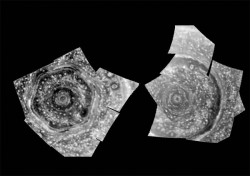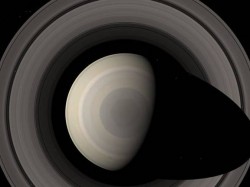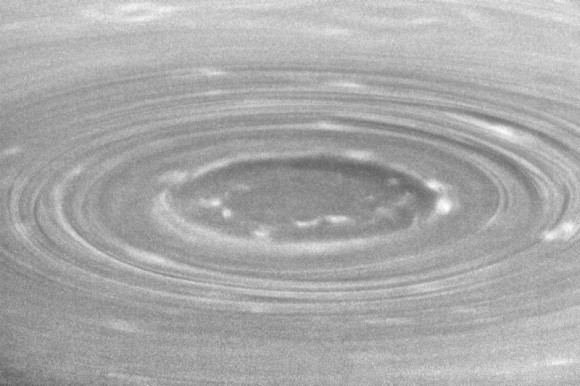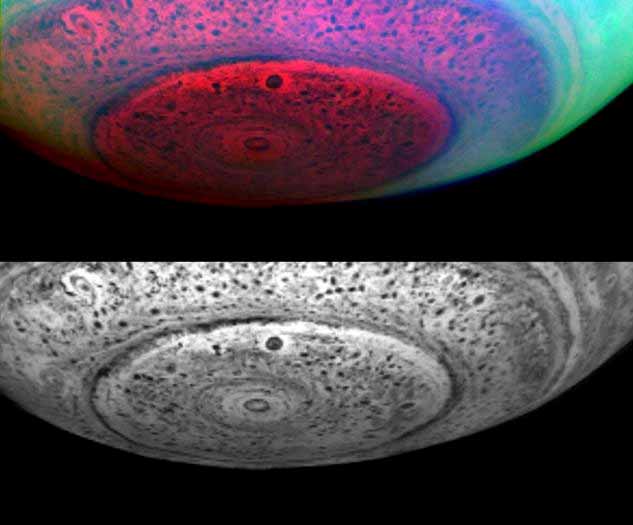[/caption]
The Cassini mission has released some of the most detailed images of Saturn’s poles yet, revealing vast cyclones churning up the gas giant’s atmosphere in the north and south. These observations show very similar storms to the south pole observations imaged by the NASA spacecraft in 2006, only in far better detail. It is believed the north and south cyclones are generated by violent thunderstorms deep inside Saturn’s atmosphere; water condensing inside these storms output heat, fuelling the vortex extending 2,500 miles (4,000 kilometres) in diameter. The smallest features resolved are 120 kilometre (75 mile)-wide cumulus clouds rotating at velocities in excess of 325 mph (530 kph), more than twice the wind speed possible on Earth…
…and the mystery north pole hexagon is still there.

“These are truly massive cyclones, hundreds of times stronger than the most giant hurricanes on Earth,” said Kevin Baines, Cassini scientist on the visual and infrared mapping spectrometer at NASA’s Jet Propulsion Laboratory. “Dozens of puffy, convectively formed cumulus clouds swirl around both poles, betraying the presence of giant thunderstorms lurking beneath. Thunderstorms are the likely engine for these giant weather systems.”

Previous observations appeared to show an outer ring of high clouds surrounding a region thought to be clear air with a few puffy clouds circulating around the pole. These brand new images reveal a far more complex picture. The circulating clouds are actually smaller convective storms forming other, more distinct rings.

Tony DelGenio of NASA’s Goddard Institute for Space Studies in New York and Cassini imaging team member explains the scene: “What looked like puffy clouds in lower resolution images [from 2006] are turning out to be deep convective structures seen through the atmospheric haze. One of them has punched through to a higher altitude and created its own little vortex.”
These clouds push high above the main weather system, casting long shadows, indicating they are 25-45 miles (40-70 km) above the vortex rings (pictured above). These also appears to be an inner ring of clear air (the “eye” of the storm) over the poles, that appeared bigger in previous observations.
For me, the most perplexing feature to come out of these new Cassini observations is the enduring hexagonal shape in the circulating clouds. In 2006 when the lower-resolution north pole observations were released, many made the assumption that it was an unstable transient feature, appearing for a short period, only to disappear soon afterwards. But over a year later, the hexagon remains, as six-sided as ever. I’d guess this shape could be some atmospheric standing wave, what do you think?
See the Cassini video of the north pole hexagon being buffetted by the high-speed winds surrounding it »
Source: Space.com


Why not a standing wave? I marvel at these Cassini pictures. Wow is the only word for now. Wow. Enjoy these marvellous pictures.
I’m thinking the Hexagonal shape in the clouds might be the result of an oscillation in Saturn’s rotation, a slight wobble which, represents it’s self in the form of a hexagon in the clouds. Kind of like taking a hubcap spinning on a stick and giving it a slight nudge in one direction.
It’s gyroscopic motion will keep it stable but the wobble will represent and repeat it’s self as the hubcap spins in the shape of different polygons. If there were some correlation perhaps between the Hexagon and the Orbit of Titan that might explain the origin of the “Nudge” on the planet.
But this is all just speculation.
Anyone has seen an update from the danish researchers, who kind of reproduced them in the lab 2 years ago?
http://www.nature.com/news/2006/060515/full/news060515-17.html
http://www.bioedonline.org/news/news.cfm?art=2531
Interestingly I have seen this kind of unexpected polygon before.
I don’t know enough about it to say that it could be linked to what we are seeing at the north pole of Saturn but take a look at http://www.physorg.com/news66924222.html and the Danish Uni site it links to.
Wow, excellent link AussieM!
That is a great link indeed – and seems to point to physics that may help understand the Saturn hexagon. Well found…
# Dutch Delight Says:
October 14th, 2008 at 6:02 am
Wow, excellent link AussieM!
X2 !!
I’ve seen patterns form in water swirls before, but never thought anything of it. I figured it was a well known event.
Gah, I’ve been trying to leave a comment here but this form isn’t working.
A very similar process happens here on Earth, just search Wikipedia for Rossby waves.
If you observe a phenomenon twice, and you don’t know anything about the persistence of that phenomenon, you cannot claim that the phenomenon was continuously present between the observations.